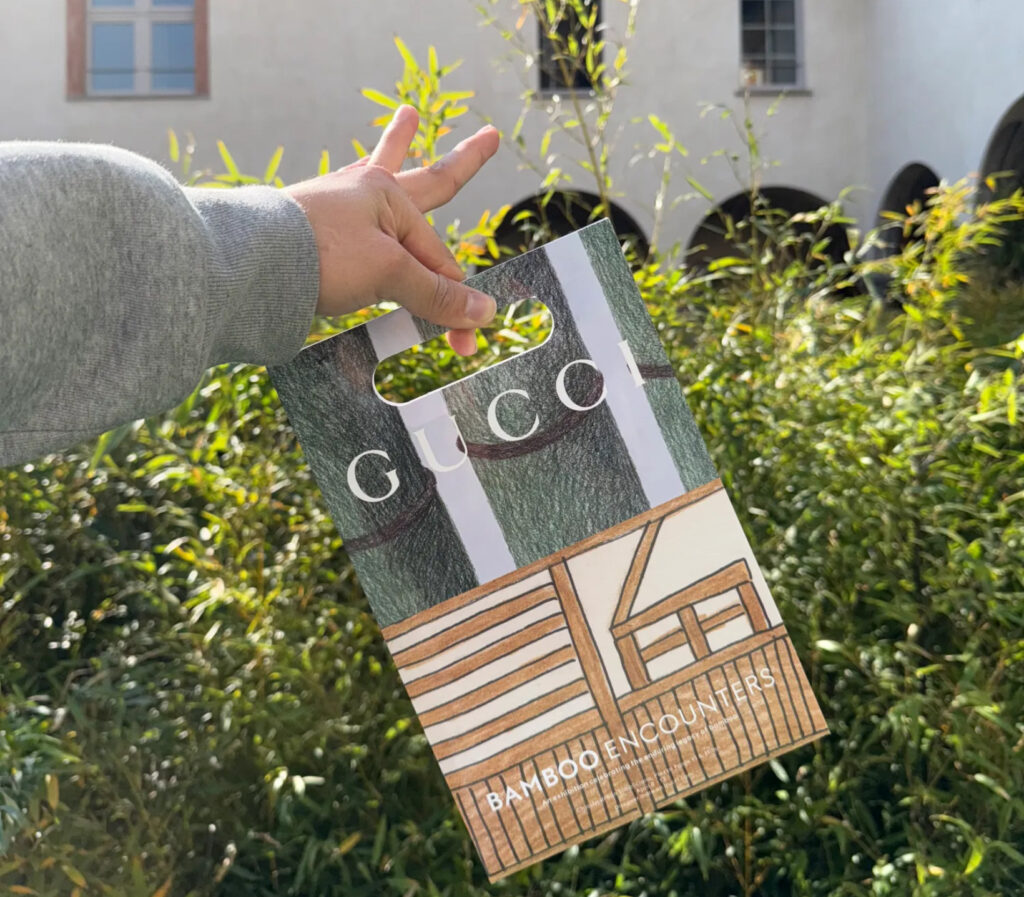


It started, as the best things do, with pastry. Not just any pastry—a pistachio crème sfogliatella from Princi. A fluted, flaky miracle with the structural integrity of a Baroque ceiling and the green swagger of a gelato Gucci collab. Foreshadowing. I hadn’t seen a Princi since the London outpost closed mid-pandemic, so finding one in Milan felt like a carb-shaped omen. I took it as a sign—something beautiful was coming. Spoiler: It was bamboo.
A short walk and a few buttery bites later, I arrived at the Chiostri di San Simpliciano, where Gucci’s Bamboo Encounters exhibition was unfolding with all the quiet drama of a Fellini dream sequence. Men in tuxedos were managing the queue like we were entering a gala at La Scala, not a cloister. It was sunny, surreal, and slightly ridiculous—which is to say: perfect. The setting—a Renaissance monastery with sun-dappled courtyards and Romanesque arches—felt like the kind of place where fashion and divinity might hold hands behind closed doors.
The Artifact That Bends But Does Not Break
The Gucci Bamboo bag is not new. In fact, it’s old. Post-war old. Created in 1947, in a moment when Italian artisans had more ingenuity than material, the bamboo handle was born not from exoticism but from scarcity. Leather was rationed. Luxury, it seemed, had to improvise. Bamboo, imported from Japan and torched into a curve by hand, became a flourish of both functionality and fantasy.
It was cinematic before it ever appeared on celluloid—though inevitably it did, on the arms of Ingrid Bergman, Elizabeth Taylor, and Vanessa Redgrave. It was a bag that refused to go unnoticed. With its serpentine handle and horsebit poise, it whispered something otherworldly into the seams of post-war austerity. And yet, it was never fixed. The bamboo bent; the design changed. And now, in the age of quiet maximalism and heritage hunger, the Bamboo is back.
But Bamboo Encounters is not merely about reissuing a bag. It’s a conversation between then and now, material and myth, Italy and the world. Alessandro Michele may have departed, but his ghost lingers in the brand’s insistence on layering history with high whimsy. Sabato De Sarno, Gucci’s new creative director, seems to understand this too: heritage is not a burden—it’s a playground.
A Cloister Reimagined: The Spatial Haunt of the Show
Inside the cloister, Gucci had built a series of intimate, almost ceremonial rooms—each dedicated to a distinct variation of the Bamboo bag, placed not as product but as relic. One room was all shadows and mirrors, evoking a kind of Byzantine clubland. Another conjured a bamboo grove through minimalist silhouettes and soundscapes, where you could hear the creak of wind-touched cane if you listened closely enough.
But perhaps the most affecting installation was the archival room—modestly lit, reverently quiet. It was here the original 1947 models stood beside their descendants. A bag that once hung from the shoulder of Princess Diana now sat next to a blood-red patent leather version updated for 2025, its edges cleaner, its attitude bolder. Time, it seemed, had done nothing but intensify its allure.
Curiously absent were QR codes or blaring screens. There was no digital pomp, no metaverse mirror. It was a radical kind of restraint: Look. Just look. And we did. We lingered. We absorbed.
Materials That Remember
At the heart of Bamboo Encounters is not just design, but the material intelligence of bamboo itself. A grass masquerading as wood, it grows faster than trees and stores more carbon. It is, in many ways, the original regenerative resource. Long before “sustainability” became a luxury buzzword, bamboo had been offering its quiet solution to wasteful excess. Gucci’s use of it today is both homage and provocation—can something ancient feel future-proof?
Crafted in Florence by artisans whose hands remember decades of heat-bending and flame-scorching, each handle is slightly different—an organic fingerprint. That imperfection is part of the bag’s seduction. In a world of algorithmic symmetry, the human curve of torched bamboo feels like an act of rebellion. It asks us to reconsider value—not in the form of branding, but in the precision of handwork.
Gucci has never been an ascetic brand. But this exhibition channels a different kind of opulence: one made not of glitter but of grain.
The Guests, the Ghosts, the Glamour
Outside in the courtyard, the Milanese fashionable mingled. There were stylists in head-to-toe archival Gucci, academics in linen blazers, tourists who stumbled in and instantly became part of the tableau. Someone lit a cigarette next to a marble pillar. Someone else took a selfie in front of an 18th-century fresco. It felt as if time was collapsing in real time—2025 brushing against 1525 with a gentle shiver.
I overheard a young couple arguing over whether the Bamboo 1947 bag was “genderless.” One insisted it was a universal object of beauty; the other replied, “Maybe—but Gucci still markets it to women.” They both had a point. The Bamboo is delicate, yes. But delicate like a sword. And the way Gucci frames it now—worn by Billie Eilish, Jodie Turner-Smith, even A$AP Rocky—it floats between genres and genders. It’s an object of desire, not definition.
There was a ghostly presence in the air, too—Alessandro Michele’s baroque fingerprints are hard to scrub from the brand’s DNA. His departure left many wondering whether the poetry would fade. But Bamboo Encounters suggests something subtler: the poetry has simply shifted its register. Where once there was flamboyant surrealism, now there’s sculptural silence.
Luxury as Memory, Not Hype
The Bamboo bag is not about seasonal trend. It’s not viral. It doesn’t shout. It remembers. And that, in today’s churn of fast drops and disposable aesthetics, is its true power. By centering an exhibition on a single object, Gucci has done something quietly radical—it has slowed the gaze.
It invites us not to consume, but to contemplate. To ask: what does it mean for luxury to endure? Not just survive, but evolve, gracefully? The Bamboo bag, born of scarcity, remade in opulence, and now reborn in sustainability, carries the answer in its curved spine.
It is a reminder that fashion—when done right—is not a business of clothes, but of emotion in motion. The way a handle creaks as you grip it. The smell of treated leather in spring air. The echo of a craftsman’s breath in a Florentine workshop.
Gucci’s Bamboo Encounters is a love letter not just to a product, but to the intimacy of design. To the slow burn of making. To the sensuality of material. To the legacy that can live inside a loop of flame-cured cane.
Epilogue: The Bag as Threshold
As I exited the cloister, past the cluster of influencers and the stray pigeons who seemed entirely unfazed by the spectacle, I felt the urge to loop back in. To see it again. To touch the air differently. But I didn’t. Some things are better left slightly unresolved.
I walked back through the cobbled streets of Brera, past gelaterias and motorbikes and couples in matching trousers. My hands still smelled faintly of pistachio. And I thought of that bag—not as accessory, but as threshold. A portal between the past and what comes next. Between fragility and fierceness. Between craft and icon.
The Bamboo doesn’t scream to be noticed. It doesn’t need to. It’s already inside you, somewhere—bending softly, impossibly, into shape.
No comments yet.








